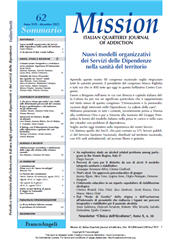A che gioco stiamo giocando? Uno studio sulle determinanti psicosociali del consumo di gioco problematico e del malessere tra gli adolescenti
43-48 p.
Introduction: "What are we playing at" is a research-intervention project to prevent and combat gambling among adolescents in the Salento area financed by the Department of Pathological Addictions of the Lecce ASL and implemented by the Department of Human and Social Sciences of the University of Salento. Various objectives were pursued by the project and initiatives implemented. Aim: In this paper we present the results of a study that aimed to explore the role of relational networks (family functioning, parental supervision, social support, approval from family and peers) and the image of the social environment in predicting problem gambling and video game use, as well as levels of well-being/malaise among adolescents. Method: 731 students (Mean age: 15,47; DS: 1,22) completed a survey that included the target variables.
A multivariate multiple regression analysis was performed to examine the role of socio-demographic characteristics and psychosocial predictors on gaming, gambling and well-being. Results: Multivariate multiple regressions identify a common core underlying problem gambling, gambling and poor well-being, but also the distinct role of psychosocial variables. The results suggest the need to examine more closely how adolescents, their activity system and culture participate in the construction of the meaning of gambling and gaming activities and their impact on adolescents' well-being. [Publisher's Text].
-
Artikel aus derselben Ausgabe (einzeln erhältlich)
-
Informationen
DOI: 10.3280/mis62-2023oa17023
ISSN: 2037-4798
KEYWORDS
- Gioco d'azzardo problematico, Gaming problematico, Benessere, Supervisione parentale, Approvazione del gioco d'azzardo, Funzionamento famigliare, Supporto sociale, Visione dell'ambiente sociale
- Problem gambling, Problem gaming, Well-being, Parental monitoring, Gambling approval, Family functioning, Social support, View of the social environment


